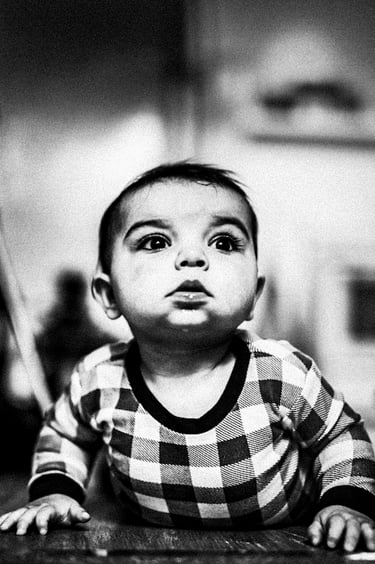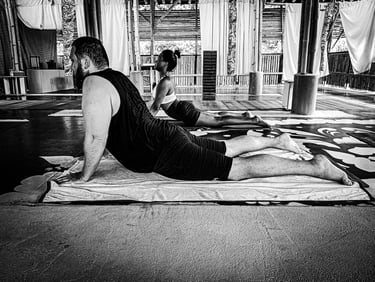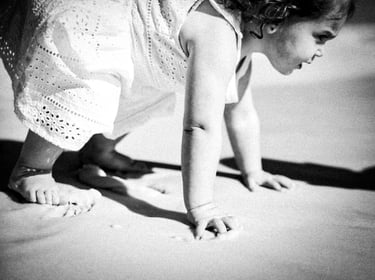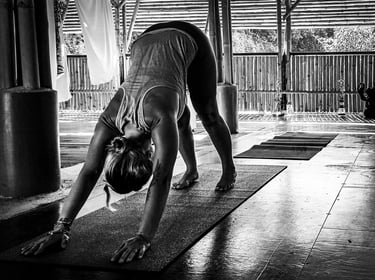Babies : Intuitive Beginners
0-3 Months:
Sphinx Pose: Babies begin to push up onto their forearms while lying on their stomachs as early as 2-3 months, strengthening their neck, shoulders, and chest. This marks the start of developing core and upper body strength, crucial for lifting the head and enhancing visual exploration.
At this stage, the cervical spine and upper thoracic muscles (like the trapezius and deltoids) begin to engage more actively, aiding head control. For adults, Sphinx Pose continues to engage these areas, promoting spinal extension and opening the chest, relieving upper back tension.
3-5 Months:
Cobra Pose: Around 3-4 months, babies lift their chest higher off the ground, resembling Cobra Pose, as they develop more upper body strength.
This action works the lower back muscles (erector spinae), further engaging the chest and shoulders. For adults, Cobra Pose enhances flexibility in the spine, reduces stiffness in the lumbar region, and strengthens the core, improving posture.
Leg Raises: Babies start lifting their legs around 3-5 months while lying on their backs, often kicking or playing with their feet, which builds abdominal and hip flexor strength.
Engaging the rectus abdominis and hip flexors in leg raises lays the groundwork for later movements like sitting and rolling. For adults, this movement builds core stability, enhances lower abdominal strength, and helps with pelvic alignment.
Babies are the perfect examples of beginners. In just 12 months, they transform in incredible ways, learning to move, balance and explore at their own pace. Each month brings exciting changes as they naturally discover movements that help strengthen and coordinate their growing bodies.
Without even thinking about it, babies perform poses that look a lot like yoga. Here’s a timeline of these natural, intuitive postures, based on typical baby development milestones, showing how they’re building strength and flexibility from the very start.




5-6 Months:
Happy Baby Pose: By 5-6 months, babies can grab their feet and bring them toward their face, similar to Happy Baby Pose. This improves hip mobility and stretches the lower back.
This pose opens the hips and stretches the spine, creating flexibility and releasing tension in the lower back. For adults, Happy Baby Pose promotes deep relaxation, supports pelvic alignment, and relieves tension in the hips and hamstrings.
Bridge Pose: Babies start experimenting with lifting their hips, often leading to rolling over, strengthening their lower back and gluteal muscles.
The lumbar spine and gluteus maximus activate in Bridge Pose. As babies progress, this movement strengthens the posterior chain. For adults, Bridge Pose stabilises the sacrum and pelvis, and improves hip extension and spinal health.
6-9 Months:
Plank Pose: As babies push up onto their hands and knees (pre-crawling stage), they often hold a pose similar to Plank before rocking back and forth.
Plank Pose develops the entire core, including the abdominals, shoulders, and legs. This foundation helps prepare babies for crawling. For adults, Plank Pose builds core strength and stability, which supports the spine and enhances endurance.
Table Top (Rocking Back and Forth): Around 6-9 months, babies balance on their hands and knees, rocking in preparation for crawling. This strengthens the core, arms, and legs.
This movement engages the deep abdominal muscles, shoulders, and hip flexors. For adults, Table Top helps stabilise the spine and is often used as a transitional pose to improve mobility and core strength.
9-12 Months:
Child’s Pose: Babies may rest in a position resembling Child’s Pose when they are tired or need a break while learning to crawl.
Child’s Pose stretches the back, hips, and thighs, promoting relaxation and recovery. For adults, it helps lengthen the spine, calm the nervous system, and release tension in the lower back and hips.
Downward Facing Dog: Babies sometimes push up onto their hands and feet, resembling Downward-Facing Dog, as they begin to explore standing.
This movement lengthens the hamstrings, calves, and spine while building shoulder and core strength. For adults, Downward Facing Dog stretches the entire body, improves flexibility, and strengthens the arms, legs, and shoulders.


These are natural and intuitive postures that babies adopt as part of their motor development. Babies instinctively move in ways that help them strengthen their muscles, develop coordination, and explore their environment. Each pose is a reflection of their growing abilities as they experiment with different positions that promote balance, flexibility, and strength.
For example, the Sphinx Pose and Cobra Pose are natural outcomes of babies learning to lift their heads and push up with their arms, which helps them engage their neck and upper body muscles. Happy Baby Pose is a playful way for babies to stretch and explore their limbs, while Bridge Pose and Downward-Facing Dog help babies strengthen their core and prepare for crawling and standing.
These movements emerge intuitively without being taught, aligning with their developmental stages as their nervous system matures and they gain greater control over their muscles and joints. This natural progression in babies mirrors many yoga postures that adults consciously adopt to maintain or improve similar physical functions throughout life.
It’s important to remember that babies don’t strive to perfect these poses - they simply move in ways that feel natural as they explore their bodies and the world around them. Despite the lack of precision, these intuitive movements still work, helping them grow stronger, more flexible, and more coordinated every day.
In the same way, we can learn from their approach by focusing less on perfecting poses and more on listening to our bodies. It’s not about achieving the perfect form - it’s about allowing the body to move and strengthen in its own time, just as babies do.


More Insights
